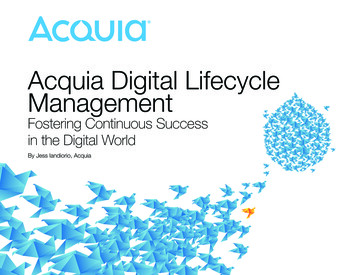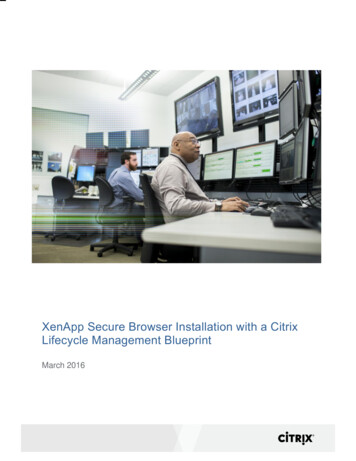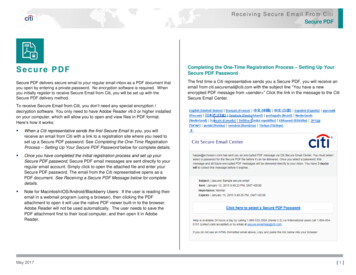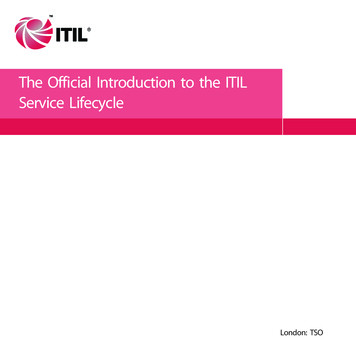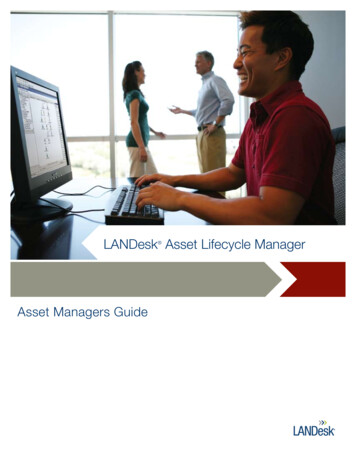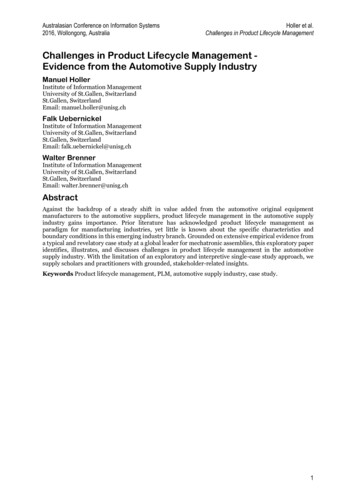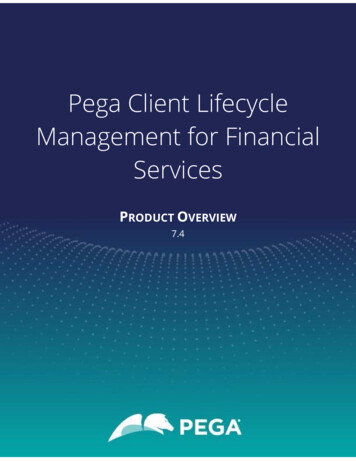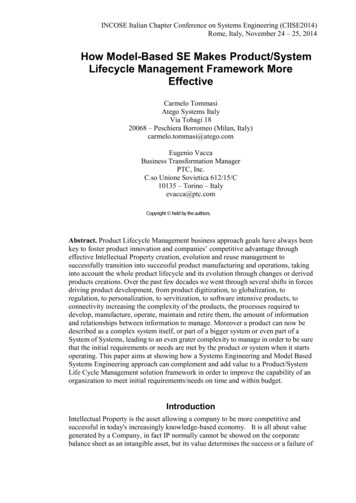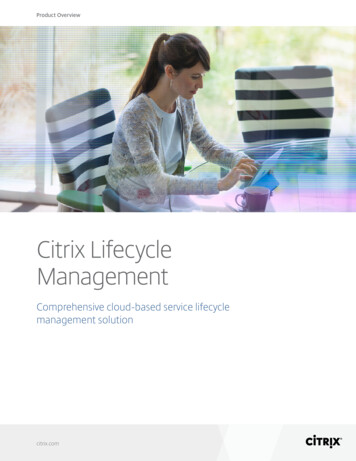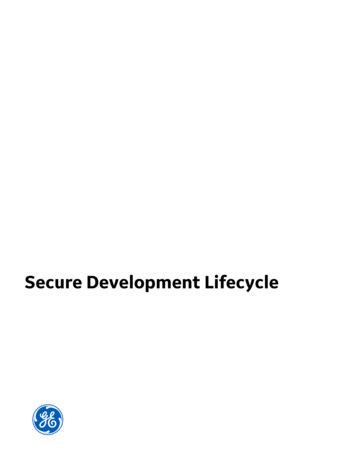
Transcription
Secure Development Lifecycle
ContentsSecure Development Lifecycleii1Secure Development Lifecycle Overview1Secure Development Lifecycle Tracks1Developer Security Training2Design/Architecture Review2Threat Modeling9Security User Stories/Security Requirements10Automated Dynamic Application Security Testing (DAST)12Automated Static Application Security Testing (SAST)13Open Source Software Vulnerability Assessment13Penetration Testing/Assessment13Secure Development Lifecycle
Secure Development LifecycleSecure Development Lifecycle OverviewPurposeThis framework establishes the GE Digital Platform & Product Cybersecurity (GED P&P Cybersecurity)Secure Development Lifecycle (SDL) guidelines for GE's customers, partners, and developers. Theframework establishes a set of requirements and direction for product safety, quality and reliability, withthe goal of reducing security risk exposure for GE Digital/Predix platform and its ecosystem of productsand services.ScopeThis framework applies to all software products and services developed by GE customers, partners, anddevelopers. It also applies to related integration efforts involving commercial or open source software.The customers, partners, and developers must have resources available to them in order to follow the SDLprior to publishing an application or service for GE Digital.Secure Development Lifecycle TracksThe GED P&P Cybersecurity SDL follows traditional “SDL for Agile” frameworks, with a few notableexceptions to gear it more towards development for the Industrial Internet. Not every task in the Agileprocess is represented as an SDL track in this procedure, but every track corresponds to a set of activitiesin the Agile process.Figure 1: SDL Tracks1
The following tracks are integral to the SDL implementation and each is explained in greater detail infocused sections further in this online artifact. Developer Security Training – Ongoing courses provided to developers to improve their understandingof techniques for identifying and mitigating security vulnerabilities. Training focuses on topics includingthreat modeling, DAST testing, and coding techniques to prevent common defects such as SQLinjection.Design/Architecture Review – A collaborative effort between the partner or customer development orengineering teams and their own product security group to assess and develop application or servicedesign patterns that mitigate risk to the platform and associated applications and services.Threat Modeling – A structured approach for analyzing the security of an application, with specialconsideration for boundaries between logical system components which often communicate acrossone or more networks.Security User Stories / Security Requirements – A description of functional and non-functionalattributes of a software product and its environment which must be in place to prevent securityvulnerabilities. Security user stories or requirements are written in the style of a functional user storyor requirement.Automated Dynamic Application Security Testing (DAST) - A process of testing an application orsoftware product in an operating state, implemented by a web application security scanner.Automated Static Application Security Testing (SAST) – A process of testing an application or softwareproduct in a non-operating state, analyzing the source code for common security vulnerabilities.Penetration Testing – Hands-on security testing of a runtime system. This sort of testing uncoversmore complex security flaws that may not be caught by DAST or SAST tools.Note: Traditional SDL for Agile does not require automated DAST or SAST, but the general industry trendis towards automation, both to promote consistent usage and to improve efficiency. This is critical fordeveloping on GE Digital or Predix's Industrial Internet applications and services.Developer Security TrainingDeveloper security training is foundational to all the security tracks highlighted in this procedure. Withoutthis training, together with experience and a security mindset, it will not be possible to do threatmodeling, write accurate security user stories, or evaluate SAST or DAST results.There are a number of paid and free resources available to customers, partners, and developers.Enterprises typically have their own SDL curriculums or training courses. Others can subscribe to onlineservices while everyone can benefit from free training provided by such organizations as SAFECode:https://training.safecode.org/Related ConceptsAutomated Dynamic Application Security Testing (DAST) on page 12Automated Static Application Security Testing (SAST) on page 13Design/Architecture ReviewAn application or service developed by a customer, partner, or developer must produce an architectureand design that has taken into account security considerations to help improve the overall GE Digitalplatform and products security posture so that everyone can benefit from it. The cost and effort ofretrofitting security after development is too high. An architecture and design review helps developmentand engineering teams validate the security-related design features of their application or service beforestarting the development phase. This allows the partner/customer to identify and fix potentialvulnerabilities before they can be exploited and before the fix requires a substantial re-engineering effort.2
The architecture and design review process analyzes the architecture and design from a cybersecurityperspective. Ideally, the design will commence with assistance from the partner/customer productsecurity teams or other experts at the concept phase. If design artifacts already exist, it should facilitatethis process nonetheless. Despite the comprehensive nature of the design documentation, thedevelopment and engineering teams must be able to decompose the application and be able to identifykey items, including trust boundaries, data flow, entry points, and privileged code. The physicaldeployment configuration of the application must also be known. Special attention must be given to thedesign approaches adapted for those areas that most commonly exhibit vulnerabilities. The guidanceprovided here will help the partner/customer develop and secure their products and services.For further information on this subject, refer to tables below: General Design Principles for Secure Software DevelopmentSecuring Web ApplicationsSecure Session ManagementTransport Layer ProtectionSecuring PasswordsMobile Application SecurityGeneral Design Principles for Secure Software DevelopmentGeneral PrinciplesKey PracticesBenefitsExamples and PracticesMinimize thenumber of highconsequencetargetsPrinciple of least privilegeMinimizes the number of actors inthe system that are granted highlevels of privilege and the amount oftime any actor can hold onto itsprivileges.In a traditional web portalapplication, the end user is onlyallowed to read, post content, andenter data into HTML forms, whilethe webmaster has all thepermissions.Separation of privileges,duties, and rolesEnsures that no single entity (humanor software) should have all theprivileges required to modify, delete,or destroy the system, components,and resources.Developers should have access tothe development and test code/systems; however, they should nothave access to the productionsystem. If developers have access tothe production system, they couldmake unauthorized edits that couldlead to a broken application or addmalicious code for their personalgain. The code needs to go throughthe appropriate approvals andtesting before productiondeployment. On the other hand,administrators should be able todeploy the package into production,but should not have the ability to editthe code.Separation of domainsMakes separation of roles andprivileges easier to implement.Database administrators should nothave control over business logic andthe application administrator shouldnot have control over the database.3
4General PrinciplesKey PracticesBenefitsExamples and PracticesDo not exposevulnerable or highconsequencecomponentsKeep program data,executables, andconfiguration dataseparatedReduces the likelihood that anattacker who gains access toprogram data will easily locate andgain access to program executablesor control/configuration data.On Unix or Linux systems, the chrootjail feature of the standard operatingsystem access controls can beconfigured to create an isolatedexecution area for software, thusserving the same purpose as a Javaor Perl sandbox.Segregate trusted entitiesfrom untrusted entitiesReduces the exposure of thesoftware’s high-consequencefunctions from its high-riskfunctions, which can be susceptibleto attacks.Java and Perl’s sandboxing and .NET’sCode Access Security mechanism inits Common Language Runtime (CLR)assigns a level privilege toexecutables contained within it. Thisprivilege level should be the minimalneeded by the functions to performits normal expected operation. If anyanomalies occur, the sandbox/CLRgenerates an exception and anexception handler prevents theexecutable from performing theunexpected operation.Minimize the number ofentry and exit pointsReduces the attack surface.Firewalls provide a single point ofcontact (chokepoint) that allows theadministrator control of trafficcoming into or out of the network.Like a firewall, strive for one entrypoint into any software entity(function, process, modulecomponent) and ideally one exitpoint.Assume environment data is Reduces the exposure of thenot trustworthysoftware to potentially maliciousexecution environment componentsor attacker-intercepted and modifiedenvironment data.Java Platform, Enterprise Edition(Java EE) components run withincontexts (for example, SystemContext, Login Context, SessionContext, Naming and DirectoryContext, etc.) that can be relied on toprovide trustworthy environmentdata at runtime to Java programs.Use only trusted interfacesto environment resourcesApplication-level programs shouldcall only other application-layerprograms, middleware, or explicitAPIs to system resources.Applications should not use APIsintended for human users ratherthan software nor rely on a systemlevel tool (versus an application-leveltool) to filter/modify the output.This practice reduces the exposureof the data passed between thesoftware and its environment.
General PrinciplesKey PracticesBenefitsExamples and PracticesDeny attackers themeans tocompromiseSimplify the designThis practice minimizes the numberof attacker-exploitablevulnerabilities and weaknesses inthe system.The software should limit thenumber of states, favor deterministicprocesses over non-deterministicprocesses, use single-tasking ratherthan multitasking wheneverpractical, use polling rather thaninterrupts, etc.Hold all actors accountableThis practice ensures that allattacker actions are observed andrecorded, contributing to the abilityto recognize and isolate/block thesource of attack patterns.Enforce accountability with thecombination of auditing and nonrepudiation measures. Auditamounts to security-focused eventlogging to record all security-relevantactions performed by the actor whileinteracting with the system. Auditsare after-the-fact and often can belabor intensive; Security-EnhancedLinux (SELinux) can be used toenforce data access using securitylabels. Non-repudiation measures,most often a digital signature, bindproof of the identity of the actorresponsible for modifying the data.Timing, synchronization, and Modeling and documenting timing,sequencing should besynchronization, and sequencingsimplified to avoid issues.issues reduce the likelihood of raceconditions, order dependencies,synchronization problems, anddeadlocks.Whenever possible, make allindividual transactions atomic, usemultiphase commits for data writes,use hierarchical locking to preventsimultaneous execution of processes,and reduce time pressures on systemprocessing.Make secure states easy toenter and vulnerable statesdifficult to enterReduces the likelihood that thesoftware will be allowed toinadvertently enter a vulnerablestate.Software should always begin andend its execution in a secure state.Design for controllabilityMakes it easier to detect attackpaths, and disengage the softwarefrom its interactions with attackers.Take caution when using thisapproach since it can open up awhole range of new attack vectors.To increase the softwarecontrollability, design the software tohave the ability to self-monitor andlimit resource usage, provideexception handling, error handling,anomaly handling, and providefeedback that enables allassumptions and models to bevalidated before decisions are taken.Design for secure failureReduces the likelihood that a failurein the software will leave itvulnerable to attack.Implement watchdog timers to checkfor the “I’m alive” signals fromprocesses and use exceptionhandling logic to correct actionsbefore a failure can occur.5
Securing Web Applications—OWASP's Code Review Guide RecommendationsGeneral PrinciplesRecommendationsAuthentication Ensure all internal and external connections (user and entity) go through an appropriateand adequate form of authentication. Ensure all pages enforce the requirements for authentication. Pass authentication credentials or sensitive information only using the HTTP POSTmethod; do not accept HTTP GET method. Ensure authentication credentials do not traverse the wire in clear text form. Ensure the application has clearly defined the user types and the rights of said users. Grant only those authorities necessary to perform a given role. Ensure the authorization mechanisms work properly, fail securely, and cannot becircumvented. Do not expose privileged accounts and operations externally. Ensure that unauthorized activities cannot take place using cookie manipulation. Encrypt the entire cookie if it contains sensitive data. Ensure secure flag is set to prevent accidental transmission over the wire in a nonsecure manner. The secure flag dictates that the cookie should only be sent over securemeans, such as Secure Sockets Layer. Do not store private information on cookies. If required, only store what is necessary.AuthorizationCookie ManagementData/Input ValidationExamine and validate all external inputs.Error Handling / InformationLeakage Ensure the application fails in a secure manner. Ensure resources are released if an error occurs. Do not expose system errors to the user. Ensure the payload being logged is of a defined maximum length and the loggingmechanism enforces that length. Log both successful and unsuccessful authentication attempts. Log access to sensitive data files. Log privilege escalations made in the application. Do not log sensitive information. Ensure the application is implementing reliable cryptographic methods.Logging/AuditingCryptography6 Do not transmit sensitive data in the clear, internally, or externally. Do not develop custom cryptography.
Session ManagementSession Management IssuesRecommendationsAttacker guessing the user’s session IDSession IDs should be created with the same standards as passwords. Thismeans that the session ID should be of considerable length and complexity.There should not be any noticeable pattern in the session IDs that could beused to predict the next ID to be issued.Attacker stealing the user’s session IDSession IDs, like all sensitive data, should be transmitted by secure means(such as HTTPS) and stored in a secure location (not publically readable).Attacker setting a user’s session ID (sessionfixation)The application should check that all session IDs in use were originallydistributed by the application server.Transport Layer ProtectionTransport Layer ProtectionRecommendationsTLS Require TLS for all sensitive pages. Non-TLS requests to these pagesshould be redirected to the TLS page. Configure your TLS provider to only support strong algorithms, forexample FIPS 140-2 compliant. Backend and other connections should also use TLS or other encryptiontechnologies.CookiesSet the secure flag on all sensitive cookies to prevent the browser fromsending any cookie with the secure flag enabled to any HTTP connections.CertificatesEnsure your certificate is valid, not expired, not revoked, and matches alldomains used by the site.Securing PasswordsPassword SecurityRecommendationsPassword ComplexityEnforce password complexity requirements established by policies orregulations. Authentication credentials should be sufficient to withstandattacks that are typical of the threats in the deployed environment. Anexample of password complexity is requiring alphabetic as well as numericand/or special characters in the password.Password Minimum LengthEnforce a minimum length requirement for passwords, as established bypolicies or regulations. OWASP recommends at least eight characters, but16 characters or the use of multi-word pass phrases provides a bettersolution.Password ChangeEnforce password changes based on requirements established in policies orregulations. Critical systems may require more frequent password changes.Password ReusePrevent password reuse. Passwords should be at least one day old beforethey can be changed.Failed LoginDisable the account after a certain number of failed login attempts.7
Password SecurityRecommendationsError MessagesDisplay generic error messages when a user types in an incorrect user nameor password.Password StorageStore passwords in the database as salted hash values.Mobile Application SecurityPassword SecurityRecommendationsInsecure Data StorageStore only what is absolutely required. Never use public storage areas, forexample SD cards. Leverage secure containers and platform-provided fileencryption APIs and do not grant files world readable or world writeablepermissions.Weak Server-Side ControlsUnderstand the additional risks mobile applications can introduce intoexisting architectures. Use the wealth of knowledge already available, forexample, OWASP Web Top 10, Cloud Top 10, cheat sheets, and developmentguides.Insufficient Transport Layer ProtectionEnsure all sensitive data leaving the device is encrypted. This includes dataover carrier networks, Wi-Fi, and so on.Client-Side InjectionSanitize or escape untrusted data before rendering or executing it. Useprepared statements for database calls (concatenation is a bad practice)and minimize the sensitive native capabilities tied to hybrid webfunctionality.Poor Authorization and AuthenticationContextual information can enhance the authentication process, but only asa part of a multifactor authentication. Never use a device ID or subscriber IDas a sole authenticator. Authenticate all API calls to paid resources.Improper Session HandlingDo not use a device identifier as a session token. Make users reauthenticateevery so often and ensure that tokens can be revoked quickly in the event ofa stolen/lost device.Security Decisions Using Distrusted InputsCheck caller’s permissions at input boundaries. Prompt the user foradditional authorization before allowing consummation of paid resources.When permission checks cannot be performed, ensure additional steps arerequired to launch sensitive actions.Side Channel Data LeakageUnderstand what third-party libraries in your application are doing with theuser data. Never log credentials, PII, or other sensitive data to system logs.Remove sensitive data before screenshots are taken. Before releasing apps,debug them to observe files created, written to, or modified in any way. Testyour application across as many platform versions as possible.Broken CryptographyEncoding, obfuscation, and serialization is not considered encryption.Prevention tips: Do not store the key with the encrypted data; use what yourplatform already provides. Do not develop in-house cryptography.Sensitive Information Disclosure8Do not store the private API keys in the client. Keep proprietary andsensitive business logic on the server. Never hard code the password.
Threat ModelingThreat modeling is a structured approach for analyzing the security of a product. Threat modelingevaluates the various attack surfaces of the product and identifies the vulnerabilities in design, therebyhelping the software architect to mitigate the effects of the threat to the system.Why should we do threat modeling?Threat modeling identifies vulnerabilities in the design phase of software development, making concernseasier and cost-effective to resolve. Also, threat modeling ensures that products are developed with builtin security from the beginning.Development teams are responsible for the security of applications they create and maintain. Each team,in consultation with GED P&P Cybersecurity, keeps a threat model of its application, operatingenvironment, and data flow boundaries.The Threat Model should be reviewed and updated by the partner or customer engineering teams andtheir product security teams at least once prior to each release.To provide visibility and the ability to audit, threat models should be posted in a central repositorylocation, with role-based access control.The benefits of continuous threat modeling include: Identify security gaps early on and tackle these in the design phase when they are most economicaland quickest to address.Reduce the number of serious, complex defects uncovered during security testing.Provide visibility across a project, clarifying the need for planning and development efforts thataddress security.Provide for a visual representation of system security components, data flows and boundaries.Maintain an up-to-date risk profile.Raise awareness across development teams so that security becomes a daily priority, alongsidefunctional development and deployment tasks.How should threat modeling be implemented?The threat modeling process can be classified in three steps:1. Decompose the systemThe threat modeling process begins with understanding the system and the way it interacts withexternal entities. Decomposing the system involves: Creating use cases to understand how the application is used.Identifying entry points to see where a potential attacker could interact with the application.Identifying assets, for example items/areas of which the attacker would be interested.Identifying trust levels which represent the access rights that the application will grant to externalentities.The partner or customer engineering team can document the above information in the Threat Model,besides using it to produce data flow diagrams for the application. The diagrams show the differentpaths through the system, highlighting the access privilege boundaries.9
2. Determine and rank threatsThreats are identified using a threat categorization methodology. A threat categorization such asSTRIDE (Spoofing, Tampering, Repudiation, Information Disclosure, Denial of Service, and Elevation ofPrivilege) can be used to define threat categories such as: Auditing and LoggingAuthenticationAuthorizationConfiguration ManagementData Protection in Storage and TransitData ValidationException Management3. Determine countermeasures and mitigationA lack of protection against a threat might indicate a vulnerability whose risk exposure could bemitigated by implementing a countermeasure. Such countermeasures can be identified using threatcountermeasure mapping lists. Once threats are assigned a risk-rank, sorting them from the highestto lowest risk is possible. Risk-ranking also simplifies prioritizing the mitigation effort and threatresponse by applying the identified countermeasures.Are there any tools available for threat modeling?GED P&P Cybersecurity recommends using the Microsoft Threat Modeling Tool 2016, which is available asa free details.aspx?id 49168Installing this tool requires a Windows machine/Windows virtual machine.When should I develop threat models?When you develop a new application or service for GE Digital, create a threat model during the designphase. When you develop a new feature on an existing application or service, update the existing threatmodel to incorporate/eliminate attack surfaces based on the new feature. Threat modeling is a livingdesign artifact for a product. It evolves with the development of a product.Where do I store the developed threat model?GED P&P Cybersecurity recommends that you store the Threat Model artifact in a safe and securelocation for your consumption and from where it can be made available for GED P&P Cybersecurity teammembers to access and review. The GED P&P Cybersecurity will review the artifact to determine whetherit meets GED P&P Cybersecurity's criteria. Every threat model version should be committed with anappropriate commit-message to identify the reason for the revision and the release in which the reviseddesign will be implemented.Security User Stories/Security RequirementsEach application or service must go through some requirements gathering to facilitate review offunctional security stories and creation of the corresponding security user stories. For instance, if aproduct calls for an authentication component, then the security user stories for this component wouldfocus on aspects such as account lockout, number of allowed failed login attempts, and passwordcomplexity. (This is not a comprehensive list.)10
Entities external of GE shall review security user stories within their development team and/or with theirSDL partner, make corrections as appropriate, and then enter these stories into the appropriate issuetracking tool. Security stories are updated as functional requirements are added, changed, or removed.Note that that there are two broad categories of security user stories:1. Evil user story – Focused on how the hacker will exploit a vulnerability to compromise the security of asystem. This sort of story is told from the hacker’s point of view.2. Nonfunctional security user story – Augments the functional definition of a product. This sort of storyprovides security guidance.The following sample set of security user stories was provided to an actual project team and was useful insecuring their product prior to public rollout. Some stories have been removed and others have beenmodified so as not to reference the original project directly.This set includes both nonfunctional security user stories and so-called evil user stories.11
ScenarioEvil StoryConsequence1Sample Project instancesavailable for publicdownload present aSHA-2 checksum.As an interested outsideparty downloading aSample Project .ova filefrom Company XYZ, I canvalidate the SHA-2 hashassociated with that .ovafile to check authenticity.1. Valid SHA-2 checksumassociated with the given Calculating Checksumova available forExample:download is presented onthe public download page. sha256sum SampleProject3.3.5.ova2. MD5 and SHA-147585bd6222948ee6b138checksums are notpresented because these 166ec2812092d46a6abbc97hash algorithms are no6028799a57egare002d4clonger collision-resistant.2Sample Project defaultpassword complies withCompany XYZ passwordcomposition rules.As an unauthorized user /hacker, I know that thedefault Sample ProjectPredix user password is"predix," enabling me toaccess an unattendedcustomer Sample Projectinstance that has beencustomized by its ownerand where sensitiveinformation has beenstored.1. All Sample Projectaccounts are deployedwith default passwordsthat comply with theCompany XYZ passwordcomposition rules.Account credentials arenot cached in Firefox orelsewhere.As a hacker, I downloadthe public version ofSample Project and openGmail in Firefox. I noticethat the credentials tocompanyxyz, mail to:predixadoption@gmail.com are cached in Firefox. Ilog in and access asecurity token posted byanother Sample Projectuser. I send maliciousemail to other SampleProject users, resulting ininformation and accountcompromise.1. Review of new SampleProject image verifies that"Remember passwords forsites" is unchecked inFirefox and that noaccount credentials havebeen cached.3NotesRefer to:Company XYZAccessManagement Policy2. phpPgAdmincredentials are no longercached in Firefox, whichled to a hyperion databasecontaining traffic camerainformation, probablyunrelated to SampleProject.Automated Dynamic Application Security Testing (DAST)Partners, customers and developers working with their product security teams or GED P&P CybersecuritySDL partner, should configure DAST scan profiles in their CI/CD build tool (ex. Jenkins) and in theapplication security scanner referenced by their build tool. This will help automate the scanning processand streamline DevOps, should the third party be using a DevOps approach to development.However, if you use a standalone SaaS-based DAST scanning tool, the tool must meet GED P&PCybersecurity requirements. The following SaaS-based DAST tools meet GED P&P Cybersecurityrequirements:12
Tinfoil : https://portswigger.net/Automated Static Application Security Testing (SAST)Partners, customers and developers working with their product security teams should configure SASTscan profiles in their CI/CD build tool, for example Jenkins, and in the SAST scanner that their built toolreferences. This will help automate the scanning process and streamline DevOps, should the partner orcustomer be using a DevOps approach to development.However, if you use a standalone SAST scanning tool, the scanning tool must meet GED P&PCybersecurity requirements. Products that can facilitate the SAST efforts are as follows, but note thatGED P&P Cybersecurity does not endorse any of the ube.org/downloads/Open Source Software Vulnerability AssessmentFixing software vulnerabilities is a crucial defense against exploitation and potential br
Automated Static Application Security Testing \(SAST\)13. Open Source Software Vulnerability Assessment13. . It also applies to related integration efforts involving commercial or open source software. The customers, partners, and developers must have resources available to them in order to follow the SDL . Like a firewall, strive for one .
